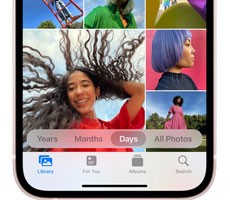Apple says the basic iPad is its most popular tablet. And why not? Back in 2017, the company introduced its cheapest-ever iPad as a budget option for schools or people who don’t need top-of-the-line specs. This device has always used hardware that’s a few years old — but Apple’s chips are so powerful that this hasn’t been an issue. Now in its ninth generation, though, the form factor is starting to feel stale; it’s virtually unchanged from the iPad Air that Apple released back in 2013. Then again, at this price who cares?
It’s not a tablet meant for early adopters like me. It’s for those who want a fast, lightweight tablet with a nice display and tons of apps, without having to spend too much or consider whether a device like the iPad Pro is the future of computing. As such, there are just a few basic questions I want to answer with this review. If you have an old iPad, what’s new and better about this one? And if you don’t have an iPad, is this the one to buy?
What’s new
To make that evaluation, let’s recap what’s new about the ninth-gen iPad. The processor powering it is Apple’s A13 Bionic chip, which first appeared in inside the iPhone 11 from 2019. It’s one year newer than the A12, which powered last year’s iPad, and it’s faster and more efficient than its predecessor. Naturally, it’s slower than the newer chips powering the iPad Air and the just-updated iPad mini, but it still delivers more than enough horsepower for a $330 tablet.
I didn’t experience any noticeable slowdowns, whether I was multitasking between Slack, writing this review in Google Docs, juggling various tabs in Safari or playing Apple Arcade games. Since this iPad has less RAM than the iPad Pro I use as my daily driver, I noticed that apps needed to refresh their content more frequently when I was heavily multitasking. But everything was quick to load up and I was back on my way again in no time.
For most people’s “standard iPad” use cases — browsing the web, editing photos, playing games, watching movies, messaging, drawing or taking notes with the Apple Pencil, writing emails or working on documents with the Smart Keyboard folio — the A13 Bionic is more than powerful enough. In fact, in our review of last year’s iPad, we found the device capable of easily transcoding and exporting 4K video into 1080p clips. It wasn’t as fast as the iPad Pro, but it was still faster than we anticipated. The A13 will only help if you’re the kind of person who likes to push their hardware.
Another new thing about the 2021 iPad is you get double the storage for the same amount of money. That means the $329 iPad has 64GB of storage this year, while the $479 comes with a healthy 256GB. As usual, you can also add LTE connectivity to these devices for an additional $130. (I reviewed the 256GB model with LTE, which costs $609.) This change is easy to evaluate: More storage is better, and it was sorely needed, particularly on the base model. 64GB should be enough for most people, but if you want to load up the iPad with games and save a lot of movies and photos to local storage, spring for the 256GB model.
The iPad’s display is essentially unchanged from the prior two models. It’s a 10.2-inch touchscreen with 2,160-by-1,620 pixel resolution. There is one change to the screen, though: It has Apple’s True Tone technology for the first time, which automatically adjusts the color temperature based on the ambient light in the room around you. Apple has offered this feature on more expensive iPads and all of its iPhones for years now, so it’s nice to see it finally in use at the lower end.
The display otherwise looks good whether you’re watching videos, playing games or browsing the web. It’s not nearly as good as the screens on the other iPads that Apple sells, though. I’m used to my iPad Pro screen, which is laminated directly to the front glass and has a 120Hz refresh rate with support for the wide P3 color gamut. But, after just sitting down and using the new iPad, I mostly didn’t think about these things. For a $330 device, it’s perfectly usable; pleasant, even. I did notice the “air gap” on the new iPad that comes from not having its display bonded to the glass, but I can accept that as a cost-cutting measure.
Finally, Apple put a new front-facing camera on the new iPad. In a somewhat surprising move, it’s the same one used on the iPad Pro (minus all the depth sensors and extra hardware needed for Face ID). It’s also identical to the one inside the new iPad mini. It’s a 12-megapixel shooter with an extremely wide field of view. That wide angle enables a feature Apple calls “Center Stage.” When you’re on a FaceTime call, the camera automatically crops in around you, rather than show the full 122-degree field of view. But since the camera has all that space to work with, it can follow you as you move around the frame. It’s an interesting feature, though usually I’m stationary during video calls. It does do a decent job of making up for the fact that the iPad’s front camera is off-center when you’re using the iPad in landscape mode, though.
I imagine Center Stage is something that will feel handy once you start to use it regularly, and I’m generally glad to see that Apple seems to have recognized that the iPad needed a better front camera. The 1.2-megapixel FaceTime camera on older iPads just doesn’t cut it in this current moment where we’re all constantly on video calls.
What’s old
Everything else about the new iPad remains unchanged. It’s the same size and weight as the last two models and features the same size screen. It has the same sizable bezels, 8-megapixel back camera, Lightning port for charging (not USB-C) and a home button with Touch ID built in. It works with the first-generation Apple Pencil (sold separately for $99), which Apple has offered since late 2015, plus the Smart Keyboard folio ($159) that Apple built for the 10.5-inch iPad Pro back in 2017. There are still two speakers at the bottom when you’re holding it in portrait orientation, which means audio still comes at you from one off-center spot when you’re watching a video. But, there’s a headphone jack!
This means it’s not the most exciting device for someone like me, but there are otherwise a lot of benefits to Apple keeping things unchanged. For one, someone replacing an iPad they bought a few years ago will be able to use the same chargers and accessories as before — something that’s particularly important for education programs and other institutions that bought iPads in bulk.
As always, Apple says the iPad’s battery lasts for 10 hours of browsing the web or watching videos over WiFi. I got a little less than that when using the iPad and its keyboard for a full day of work, but the iPad far surpassed that estimate when I was watching videos. I got closer to 14 hours before the battery finally kicked it. Naturally, you’ll enjoy less runtime when doing more intensive tasks like gaming.
Living with iPadOS 15
Despite the ho-hum design, the user experience felt fresh, thanks largely to iPadOS 15. I’ve been using the updated software in beta since the summer, and I’m glad to say that the final release is solid. Apple addressed the biggest problems I had with iPadOS 15 (some illogical design changes to Safari), and many of the changes make the iPad experience significantly better.
Quick Notes is a great feature for Apple Pencil users and makes the iPad a much better note-taking device. Obviously, it’s handy to be able to quickly summon a new space to scribble in, but the fact that Notes recognizes when you’re on a website or specific Map location and lets you save them to the note is particularly useful.
Now that Safari has restored a traditional tab view instead of the cramped compact view from iPadOS 15 betas, I can appreciate some of the other changes this year to the browser. Tab Groups are a convenient way to organize things when you want to separate out what you’re browsing by category; I often use it to keep research for stories all in one place. And being able to find links that were shared with me through the Messages app is handy, too.
The variety of new multitasking gestures took a little getting used to, but they make it easier to set up various spaces with the right combination of apps for what you’re trying to do. The iPad’s 10.2-inch screen is almost too small for doing much in multitasking mode, but it’s still useful to have a bunch of my most-used apps a swipe aways in Slide Over. And the new “shelf” that appears when you launch an app to show you other spaces the app is running in is another smart addition I’ve been using a lot.
Other new changes are taking me longer to set up the way I’d like. The notification summary feature, which lets you set up a time for notifications from specific apps to be delivered, is a clever idea in theory. But I haven’t yet figured out which apps I want to relegate to the summary and which ones I’d rather show up immediately. Similarly, the new Focus features let you set up multiple do not disturb scenarios, each of which can have its own schedule, apps or people allowed or blocked and home screens that are hidden or active. It’s extremely flexible, but I haven’t yet figured out how to make the most of it.
The learning curve aside, iPadOS 15 is a solid release, and it runs well on the new iPad. If you buy this tablet now, it should receive similar updates for years to come, which will go a long way toward keeping it fresh even though it was never a cutting-edge device.
Wrap-up
Coming from the iPad Pro, I was pleasantly surprised at how capable the new iPad is. I’ve gotten used to using the Magic Keyboard and its trackpad for work, so I found the new iPad’s $159 Smart Keyboard folio lacking. Between that and the smaller screen, it’s not my first choice for tasks that require me to keep an eye on multiple things simultaneously.
But it was a great device for drafting this review plus all the “iPad things” I want to do when I’m not working. I found myself using the iPad handheld, with its keyboard tucked away, more often than I expected. Being able to quickly flip back the keyboard t and use the iPad with two hands and then switch to typing when I wanted to bang out an email or reply to a message became a pretty common couch workflow.
Overall, I could do just about everything I can with my iPad Pro on the new iPad. There are a few slight changes and compromises here — but for the consumers Apple is targeting, those things might be moot. The iPad remains a very good tablet at a fair price. If you want something more modern, I don’t blame you, and would instead point you toward the iPad Air, which hits a sweet spot of performance, features and price.
If you’ve bought an iPad in the last two years, there’s no need to upgrade — but people with one older than the fall 2019 iPad will find some significant improvements here. If you’ve never bought one before, the new iPad delivers a surprisingly deep experience, despite its aging design.
Source: Engadget – Apple iPad (2021) review: Another modest update













